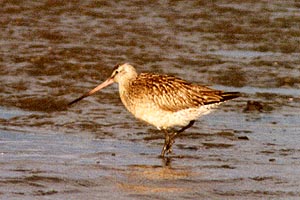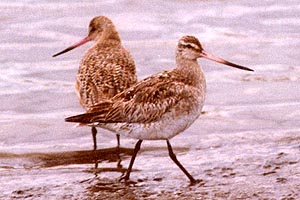 An
obvious godwit, with long straight bill, pink at the base and slightly upturned near the tip. The bird was slightly
smaller than adjacent Marbled Godwits, with a paler face, and underparts and larger pale-buff spots on the upperparts.
The blue-gray legs were decidedly shorter than Marbled Godwit with the difference most apparent in the tibia and
the neck was also clearly shorter than adjacent Marbled Godwits.
An
obvious godwit, with long straight bill, pink at the base and slightly upturned near the tip. The bird was slightly
smaller than adjacent Marbled Godwits, with a paler face, and underparts and larger pale-buff spots on the upperparts.
The blue-gray legs were decidedly shorter than Marbled Godwit with the difference most apparent in the tibia and
the neck was also clearly shorter than adjacent Marbled Godwits.
The head pattern was much more distinct than on Marbled Godwit. The Bar-tailed had a broad whitish supercilium meeting across the forehead, setting off a gray-brown cap. A dark line through the eye bordered the supercilium from below.
The underparts were paler buff than on Marbled Godwit becoming almost whitish on the belly and undertail coverts. The undertail coverts were very long reaching almost all the way to the tip of the tail. The breast and sides were warm buff, and that color extended laterally around the flanks to the tips of the undertail coverts, where the color was much paler. The foreneck and breast were lightly streaked with brown, and some bolder dark bars appeared along the flanks.
The upperparts were a darker brown than on Marbled Godwit, with larger, paler notches in the tertials, coverts, and scapulars. The center of the back was dark brown. In general, the upperpart pattern more closely resembled the pattern of nearby Whimbrel, than adjacent Marbled Godwit.
The primary projection was quite long, and the primaries extended beyond the tail with the tips often crossing each other. At least three black primaries were visible beyond the folded tertials, however the bird often held its wing slightly drooped so that more primaries were visible just below the folded wing. Some of these showed very narrow whitish fringes to the black primary tips.
The tail was more boldly barred than Marbled Godwit. The tips of the rectrices were noticeably pointed and there was a narrow dark subterminal bar with a white bar just anterior to it. Then the bars got progressively narrower with more buff showing toward the base of the tail, especially in flight. I believe this may have been caused by a buff suffusion on the lateral rectrices which was not visible while viewing the folded tail from above.
 In
flight, it was possible to see the whitish rump, but it was extensively barred with brown. The grayish-white underwings
were likewise prominently barred. These markings are characteristic of the Alaska and eastern Siberian breeding
race L. l. Bauri. A faint wing-stripe was also evident in flight.
In
flight, it was possible to see the whitish rump, but it was extensively barred with brown. The grayish-white underwings
were likewise prominently barred. These markings are characteristic of the Alaska and eastern Siberian breeding
race L. l. Bauri. A faint wing-stripe was also evident in flight.
 Today Dan Singer and I decided to spend the morning birding the San Mateo County coast. Large flocks
of seabirds were actively foraging at a number of stops. At the pullout just south of the San Gregorio Creek Bridge
we watched numerous Black-vented Shearwaters, Parasitic Jaegers, and one Marbled Murrelet as well as more common
species. Dan pointed out an unusual godwit on the far side of the freshwater pond, but it was too far away to be
sure. It seemed to have too much buff on the belly for Bar-tailed, but it had fairly long primary projection. Eventually
we decided to pay the fee at the parking lot, and walk the trail out to the bluff. Below us, the unusual godwit
was much closer and after studying it for a few minutes, we concluded it was a juvenile Bar-tailed Godwit.
Today Dan Singer and I decided to spend the morning birding the San Mateo County coast. Large flocks
of seabirds were actively foraging at a number of stops. At the pullout just south of the San Gregorio Creek Bridge
we watched numerous Black-vented Shearwaters, Parasitic Jaegers, and one Marbled Murrelet as well as more common
species. Dan pointed out an unusual godwit on the far side of the freshwater pond, but it was too far away to be
sure. It seemed to have too much buff on the belly for Bar-tailed, but it had fairly long primary projection. Eventually
we decided to pay the fee at the parking lot, and walk the trail out to the bluff. Below us, the unusual godwit
was much closer and after studying it for a few minutes, we concluded it was a juvenile Bar-tailed Godwit.